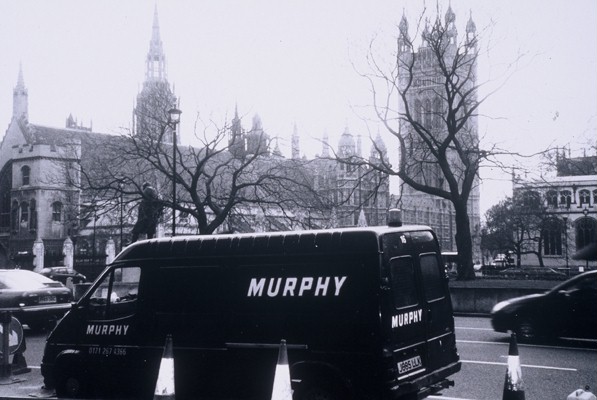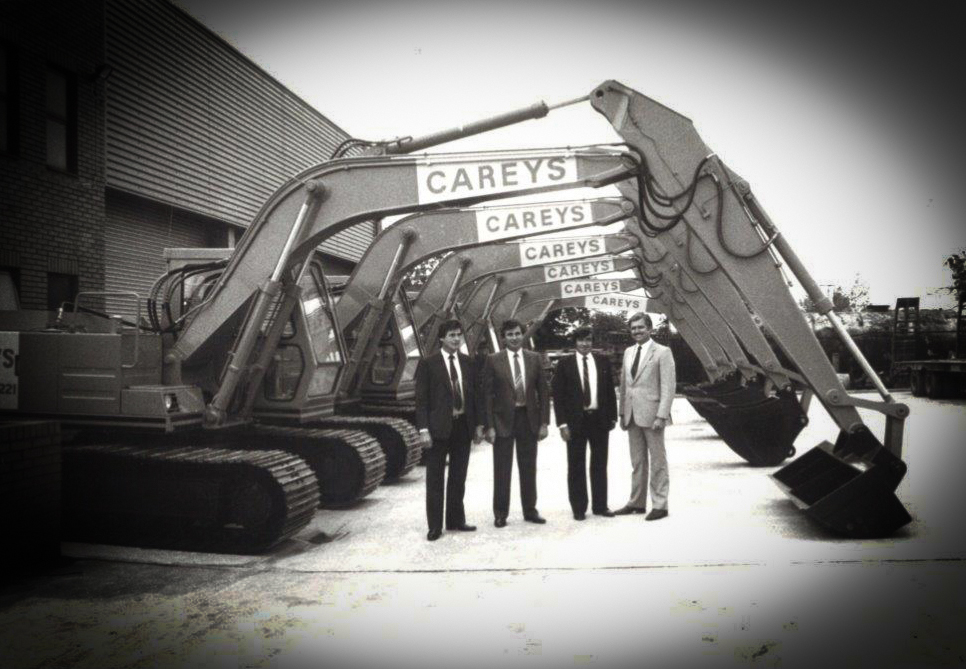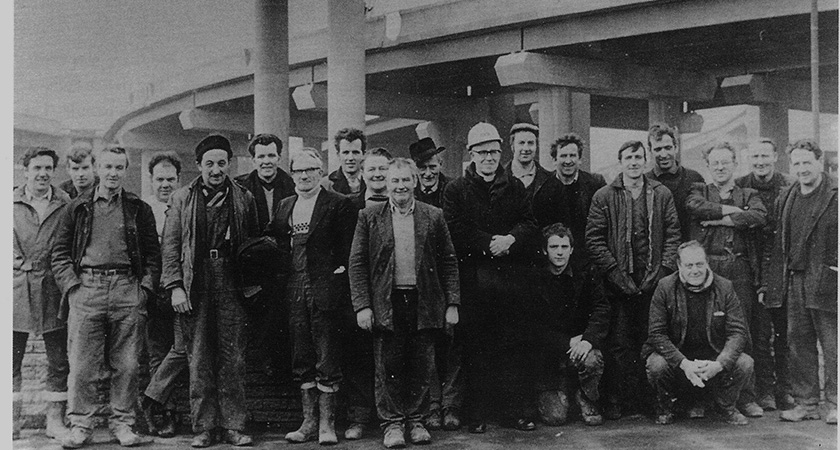TWENTY years ago my book The Men Who Built Britain was launched – coincidentally, by the man who is today President of Ireland, Michael D. Higgins.
Much has changed since then...
Untangled from the long histories of Irish emigration and British civil engineering, that work told the dramatic story of the Irish navvies – those transient migrants who hewed their way out of trench and tunnel to dominate whole sectors of Britain’s construction industry.
For young migrant males from rural Ireland, arriving in Britain with few material resources but well equipped with toughness, tenacity, and common sense it guaranteed ‘the start’.
In 1960 they numbered upwards of 200,000 men, and already successful subcontractors were emerging from the scrum.
Amongst Irish names getting noticed in the era of post-war reconstruction were McNicholas, Murphy, Kennedy, Clancy, Carey, Byrne, Gleeson, and Fitzpatrick.
 The Murphy group was one of the early Irish firms to carve a space in Britain's construction industry
The Murphy group was one of the early Irish firms to carve a space in Britain's construction industryAmazingly, however, even fifty years earlier some men had already commenced their rise from tradesman to contractor status.
Michael J. Gleeson left Cloonmore in East Galway in 1903 to work as a brickie for another Cloonmore man who was then a builder in Sheffield.
In time MJ married his employer’s daughter and inherited the family business.
A shrewd businessman, MJ expanded into civil engineering, while growing the house building business both north and south.
In 1960, under the chairmanship of MJ’s nephew Jack, the firm became the first Irish-owned construction company to gain a listing on the London Stock Exchange.
Amongst their other ‘firsts’ is the fact that, even today, MJ Gleeson plc can claim to have built more dams than any other UK contractor.
Some twenty years ahead of Gleeson, Pat Fitzpatrick had left Cork for London, employing his stonework skills to set up as a street mason.
In 1921 his son John Martin established Fitzpatrick & Son, specialising in concrete paving, officially registering the company in 1938.
A little over thirty years later, after exponential growth in areas such as highways improvement and runway construction, Fitzpatrick & Son Ltd. were acquired by Tarmac Construction.
In the 1980s John Martin’s son Patrick then re-acquired the company, going on to form the highly successful Fitzpatrick plc.
In 2004 the company merged with Dutch specialists Royal VolkerWessels to become VolkerFitzpatrick.
 The Carey group has enjoyed a lengthy and successful career in Britain
The Carey group has enjoyed a lengthy and successful career in BritainThese individuals emigrated with trades. As such as they were exceptional.
Prior to World War Two the vast bulk of Irish male migrant labour was unskilled.
In the 19th and early 20th centuries most men came to Britain as seasonal harvesters – Spailpins and Tattie Hokers, some progressing to navvying on public works (it took a year to turn a farm labourer into a navvy).
The middle decades of the last century witnessed a dramatic breakthrough by Irish labour into British contracting.
Britain’s wartime labour shortage had given the Irish access to careers hitherto closed to them and post-war reconstruction created unprecedented opportunities in civil engineering, construction, and utilities.
A virtual constellation of contractors emerged then whose stories would merit a book of their own. One Irishman whose stellar career, uniquely, bridged both worlds was Pat McNicholas – the famous ‘Pincher Mac’, who is reputed to have left Mayo in the early 1920’s, aged fourteen, to work for farmers in East Anglia.
Through the ‘20s and ‘30s Pat progressed to labouring for British contractors such as Laing and McAlpine on large civil engineering contracts.
These were the twilight years of the Long Distance Men, or Pincher Kiddies, who ‘followed the money’ from job to job, in the manner of the Tramp Navvies of the Railway Age.
Pat worked on bomb damage repairs and demolition and, seeing opportunities where others saw only hardship, teamed up with his brother Michael to bid for cut-and-cover contracts repairing and installing the utilities networks.
Eventually, by dividing the utilities between them, they formed two successful companies instead of one - so much for the myth of the ‘thick Paddy’.
That approach was emulated by other Irish sub-contractors, the Kennedys from Mayo and the Murphys from Kerry not least amongst them, and over time a large Irish labour pool was created from which many other successful start-ups emerged.
 O'Donovan Waste is another strong Irish firm which has maintained its position in the British market for many years
O'Donovan Waste is another strong Irish firm which has maintained its position in the British market for many yearsAmbitious beginners brought in expertise and investment.
This ad., placed in Labour News and dated April 1956, is a good example:
‘Directorship offered in Limited Company engaged in GPO and other engineering work. To young man, energetic, capable and good organiser, willing to travel and take charge of outside work and control labour (profession not essential). Capital outlay about £1,000. Good opportunity for expansion. Replies treated confidentially.’
Irish dominance of ground works throughout the industry became a feature of the second half of the 20th century.
As well as generalists, some notable specialists emerged, not all of whom are widely known.
One who stands out for me is Roger Byrne.
Son of a navvy well known in North London, Roger trained as a brickie, was named John Laing Apprentice of the Year in 1978 and, as a foreman for Ben Barrett Brickwork at age 24, was responsible for overseeing the famous 16 Arches of Commodity Quay (Taylor Woodrow), the second biggest arches in London after St. Pancras.
Roger’s own brickwork company, Reussir Ltd., was voted No. 1 in Britain in 2006, 2007, and 2013. Having built Cardiff City Football Stadium for Laing O’Rourke, Reussir became the main brickwork contractor to Carillion.
They built many prestigious Carillion projects, including the £500 million Southmead Hospital in Bristol, which featured some of the best natural pennant stonework seen in Britain.
They were one year into a two year contract for Carillion when the latter went bust.
Losses were heavy and in 2019 the company went into voluntary liquidation.
A sad end to a distinguished Irish endeavour - but the work endures.
 A largely Irish migrant labour force were responsible for building what would become known as Spaghetti Junction in Birmingham (PIC: Brendan Farrell)
A largely Irish migrant labour force were responsible for building what would become known as Spaghetti Junction in Birmingham (PIC: Brendan Farrell)Recent years have marked significant milestones in the history of the Irish in British construction. The Carey and Byrne Groups marked their 50th anniversaries in 2019 as did O’Donovan Waste, an Irish-owned downstream operation increasingly vital to the industry, and a model of its kind.
Clancy Dowcra celebrated their 60th in the same year while John Murphy & Sons turned 75 in 2020. This year Pat Fitzpatrick’s company celebrates its 100th anniversary.
McAlpine, of Scottish origin but once the go-to firm for Irishmen fresh off the boat and looking for the start, marked its 150th in 2019.
The last twenty years have seen the exponential growth of new Irish players in the industry.
The Irish Post annually publishes an exhaustive and impressive list.
Bridging the two epochs is Laing O’Rourke.
O’Rourke began as a ‘pony boy’ for Murphy and, in the time-honoured way, quickly put brains before brawn to become an entrepreneurial builder whose creative use of concrete was as innovative as ‘Concrete Bob’ McAlpine’s had been a century before him.
The acquisition of Laing in 2001, one of the ‘grand old men’ of indigenous British construction, was a historic moment not just for O’Rourke but for the entire Irish construction family.
It turned the traditional relationship between Irish labour and British construction completely on its head.
Nevertheless, most of the twentieth century pioneers have now left the stage – or the site if you prefer, and their world is almost beyond living memory.
Indeed, watching a recent seven-minute Laing O’Rourke promotional video, it struck me that while there was a different L. O’R. employee on screen every thirty seconds, only three had Irish accents – one being the chairman himself.
So, in the twenty years since The Men Who Built Britain was first published, an entire world has passed away - even I am now seventy five.
Less than one hundred copies of this book still remain.
Get one while you can – it won’t be reissued.
For further information or to order a copy of the book The Men Who Built Britain: A History of the Irish Navvy, by Ultan Cowley, click here.
McAlpine's Men & Voices of the men who built Britain (CD) can be ordered here.


